Here at DC Histories, we try to make sense of the continuity that perplexes, befuddles, and intimidates. We discuss what worked and what didn’t. This week, we’re talking about the legendary Justice Society of America.
The JSA first sat around a conference table in 1940. Just two years after Superman debuted, National Publications and All-American Publications agreed to have their characters appear together in a series titled All-Star Comics. Eventually, these two publishers merged to create the modern day DC Comics, but for now they were just sister companies.
The first two issues of the All-Star Comics was just an anthology comic which collected individual tales of these two publishers’ superheroes. The third issue of the series mostly followed suit with this format but with an important new feature. In the third issue, a framework for these stories was presented. Now, these superheroes met together and discussed their stories with each other. They called themselves the Justice Society of America and while their first issue together was low on teamwork, it managed to get fans talking.
It was the very first time a group of individual heroes had given themselves a team name.
Realizing that they’d hit gold, National and All-American changed All-Star Comics from being a quarterly publication to a bimonthly publication. They also allowed the heroes to adventure together, not just sit and around talk about previous solo stories for an entire issue. Over time, most of the heroes owned by these publishers made their way into the JSA, including heavy hitters Superman and Batman, though the pair only joined for a single issue. Wonder Woman was added to the team, which helped with diversity, but she was immediately made the group’s secretary because it was the 1940s and what are you gonna do?
All-Star Comics was quietly cancelled in 1951 when superhero comics sales went in the tank. Only Superman, Batman, and Wonder Woman comics survived the changeover when comics started focusing on westerns, horror, crime, and other topics.
Future continuity would claim that the JSA went into retirement in 1951 because they had been called before Senator Joseph McCarthy’s House Un-American Activities Committee. While testifying before Congress, the group was asked to reveal their secret identities so that they could be cleared as Communists. Hawkman, the JSA’s chairman, refused and told the committee that they were retiring effective immediately. With that, the JSA teleported away thanks to Dr. Fate’s magic.
The JSA remained out of the public eye for years.
Nearly a decade later, near the beginning of the Silver Age, the Justice League of America debuted. Editor Julius Schwartz and writer Gardner Fox thought that the JSA concept was a great one so, in 1960, they brought together some of the current heroes in DC’s roster. Thinking that ‘Society’ was old fashioned, the name ‘League’ was added to this group.
Due to the many continuity errors that developed between the original Golden Age superhero tales and the relaunched Silver Age tales, it was decided that these stories had existed on worlds separated by being on different vibrational planes. The current tales of Hal Jordan, Barry Allen, and the rest were on Earth-1 while the tales of heroes like Alan Scott and Jay Garrick were set on Earth-2. In the very first Crisis in DC history, the JSA came out of a twelve year retirement to meet their younger allies.
This team-up was so well received that the JLA/JSA crossover became an annual event. Readers eagerly awaited it every year.
That’s how the status quo remained for decades. The JSA was just off in its own little world with very little influence from the regular DCU. The JSA slowly began to change up its membership when All-Star Comics was relaunched in 1976. It was during this series that characters like Power Girl and a grown up Dick Grayson Robin were introduced. With fresh blood added to the mix, things were looking up for the Justice Society.
The Crisis on Infinite Earths changed everything. This Crisis was devised as a way to clean up the DCU’s continuity. To that end, the multiverse was destroyed. Now, there was no Earth-1 and Earth-2. There was just Earth. Fearing that the JSA made things a bit confusing for readers, the editors at DC decided to send the JSA away forever. The Justice Society learned that Hitler’s occult machinations during World War II had brought about the Norse concept of Ragnarok. Ragnarok was the literal end of the world thanks to ancient gods battling with one another. The Spectre and Dr. Fate managed to plop the JSA down in the middle of this larger-than-life fight in order to subdue the problem and save the world.
Even though the JSA defeated their enemy, it turned out that this battle was a neverending one. Each time the fight ended, it reset itself back to the beginning again. The JSA found themselves battling the same foes until the end of time. Only a handful of members like Power Girl, Dr. Fate, and the Star-Spangled Kid were able to leave Limbo before they were stuck alongside their comrades.
That should have been the end of the story. However, a 1991 miniseries changed everything. With very little fanfare, a comic called Justice Society of America hit store shelves. Written by Len Strazewski, who was given this title as an afterthought by DC until his next substantial project started, this miniseries told the tale of a forgotten JSA adventure from 1950. Only five members of the JSA appeared in this 8-issue long story, but their opponent of Vandal Savage sporting one of Starman’s Gravity Rods was a memorable one.
Response to this miniseries was very strong. Even more importantly, sales were strong. Sales were so strong, in fact, that DC decided to bring the JSA out of Limbo. The next year, during a fairly awful miniseries titled Armageddon: Inferno, a character named Waverider was able to find stand-ins for the JSA in their Ragnarok battle and he brought the old-timers back to Earth. Luckily, Limbo had kept everyone looking a bit younger than the calendar claimed.
Just a few months later, a new volume of Justice Society of America was launched. During this series, the JSA casually interacted with the other denizens of the DCU. Guy Gardner, Superman, and Wally West all made guest appearances in this book but it was the original JSAers who were the stars.
This series, like the miniseries from a year earlier, was written by Len Strazewski. The pencils on the book were by Mike Parobeck, a young artist who I mentioned back in the article on Animated DCU Tie-Ins. Parobeck’s clean lines were a sight to behold and one of the big reasons that a tween like me loved this book. Plus, all of the heroes looked like they were having a good time and that was really attractive to me.
A large claim-to-fame that this series has is that it was where Jesse Quick, daughter of the Golden Age hero Johnny Quick, was introduced. Over the coming decades, Jesse would be a major supporting character in Wally West’s Flash series and would become the character known as Liberty Belle.
Sadly, this series lasted only ten issues. In a June, 1998 interview, Strazewski claimed that the series wasn’t cancelled due to sales. He claimed that it was actually cancelled because Mike Carlin, then the editor of the very popular Superman line of books and major decision maker at DC, didn’t like the book. Carlin was said to feel that the JSA made DC look old while other contemporary comics companies, like Image, were selling books to the next generation of readers. It couldn’t have helped that in Justice Society of America (Vol. 2)’s first issue, Wesley Dodds, the Sandman, suffered a stroke. That’s not exactly a problem with which many young people could relate.
Those ten issues are still among my favorite comics due in no small part to Parobeck’s art. I love it to this day.
The following year, more evidence was added to the idea that Mike Carlin disliked the JSA. During the pages of Zero Hour, a crossover event that Mike Carlin edited, the JSA was decimated in mere pages by the villain Extant. During the melee, Extant killed several heroes and aged others. The protection against time that Limbo had given the group was stripped away.
Luckily, future writers ignored just how much this story aged certain characters. When Ted Knight and Jay Garrick next appeared, they looked much better than they did here.
Thanks to the wholesale slaughter of the JSA, the group was gone for half a decade. Other heroes took the spot of many of their dead namesakes but few of them stuck. Jack Knight, son of Ted Knight, had a very popular run as Starman but other characters, like a gentleman known as just Fate, weren’t so lucky. In 1999, DC decided to bring back the JSA in the style of the recently relaunched JLA. But first, a series of one-shots told a tale of the original Justice Society during their heyday.
These one-shots may be best remembered for their inclusion of a scene where Dr. Mid-Nite’s owl is given superpowers by Hourman’s drugs and proceeds to fly straight through a villain’s chest. It happened and it was wonderful.
The month after this story wrapped up, JSA launched. Though it was mostly full of the offspring and sidekicks of the original Justice Society, it still boasted the original members Green Lantern, Flash, Wildcat, and Wonder Woman’s mother, Queen Hippolyta. That last addition was a fancy bit of retconning by John Byrne who had Queen Hippolyta travel back to World War II during his run on Wonder Woman. She was said to be the one wearing the red, white, and blue costume during those early adventures and not Diana. That left the modern Wonder Woman’s reintroduction in 1987 intact.
JSA continued for the next several years, where it eventually saw the addition of many more heroes to its ranks. The heart of the JSA, the thing that made this group special, was that it was both a family and a superteam, which is more than any incarnation of the JLA can claim.
Shortly after Infinite Crisis, the series got rebooted with a new title, new numbering, and a slightly new cast. Among the members of the team was Jesse Quick, now calling herself Liberty Belle. She and the original Hourman’s son were married and made for a lovely couple. The series quickly got ensnared by a massive storyline dealing with an alternate future depicted in the Kingdom Come miniseries, but it still remained a great read.
Sadly, the series flagged a bit near the end of its run. While I can’t fault editors, writers, and artists for attempting something new, especially with heroes who have been around since the late 1930s, it was a questionable decision to change Green Lantern’s costume into one that looked like a real lantern.
Shortly before the New 52, Justice Society of America and its spin-off title JSA All-Stars were cancelled. When the New 52 launched, none of the original JSA members were anywhere to be found. Now it seems that the JSA will be showing up over in the pages of Earth 2. While I’m happy that they’ll be back soon, I’m a little less excited about seeing more of Jay Garrick’s new costume. Time will tell if this is the same JSA who have been fighting villains since 1940 or if they’ll be back in name only. In either case, the Justice Society of America’s crazy, 70 year long story is opening a new chapter soon and I, for one, am interesting in finding out more about it.
Jeff Reid wonders what the original JSA thought about having the Spectre on their team. He must have creeped them all out. Anyway, follow Jeff on Twitter.
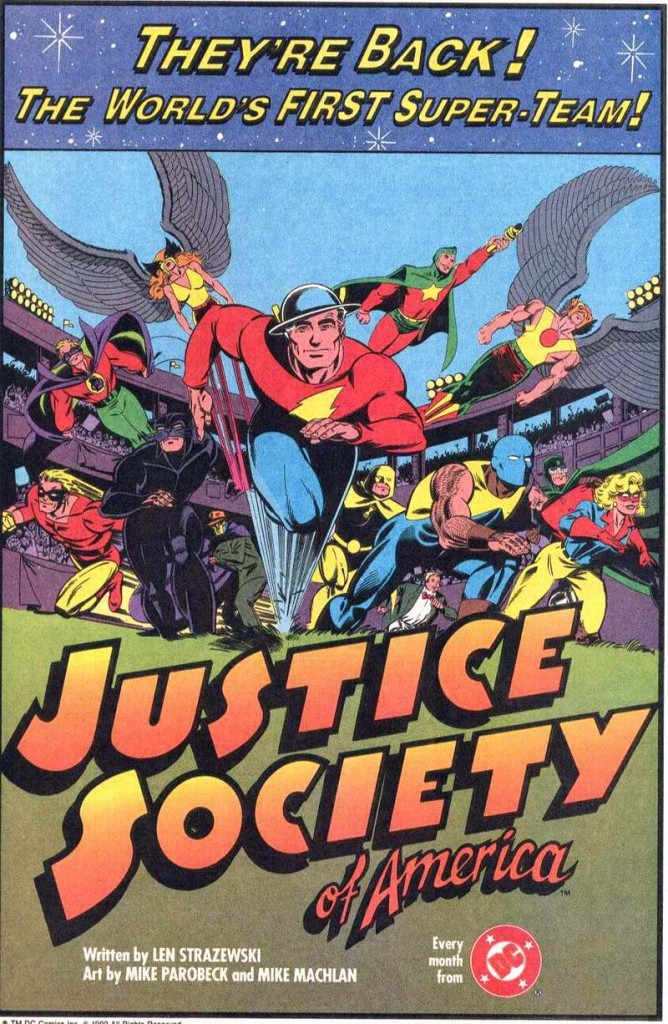
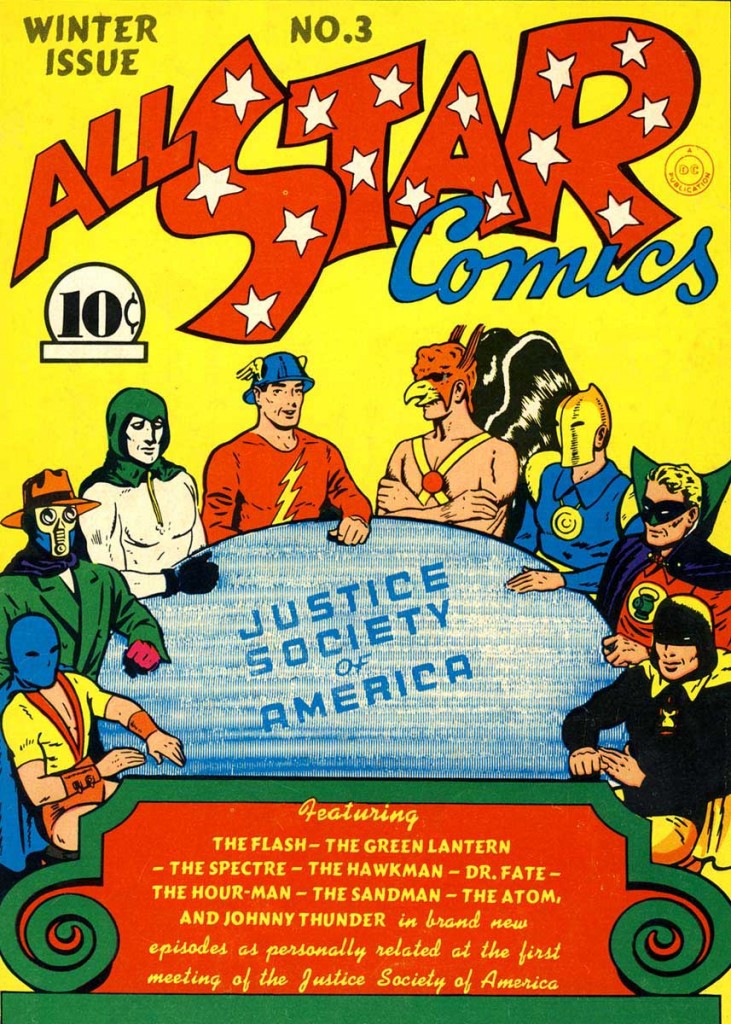

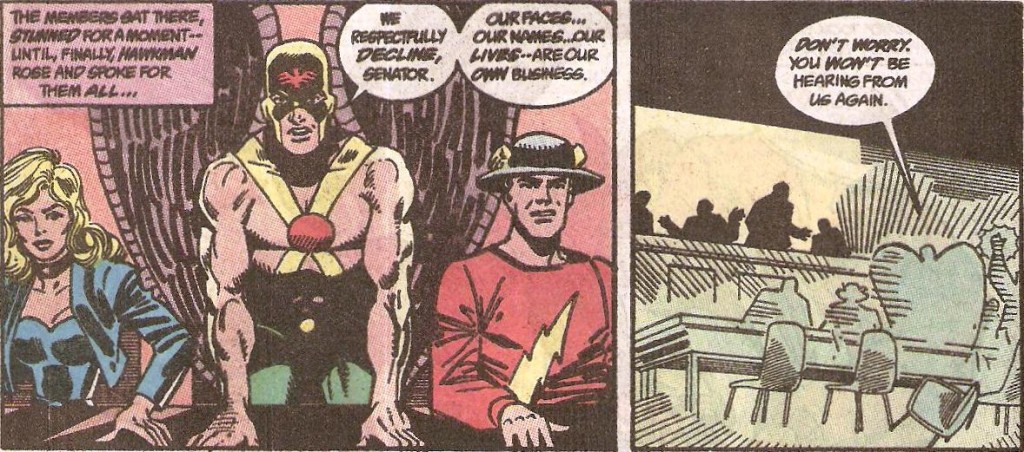
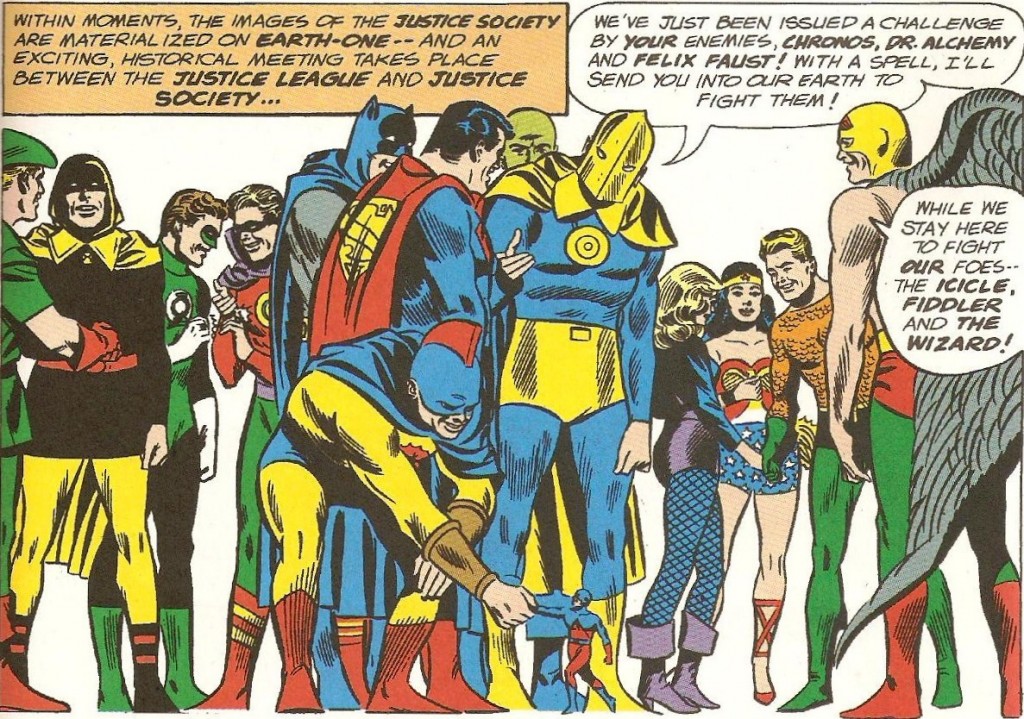


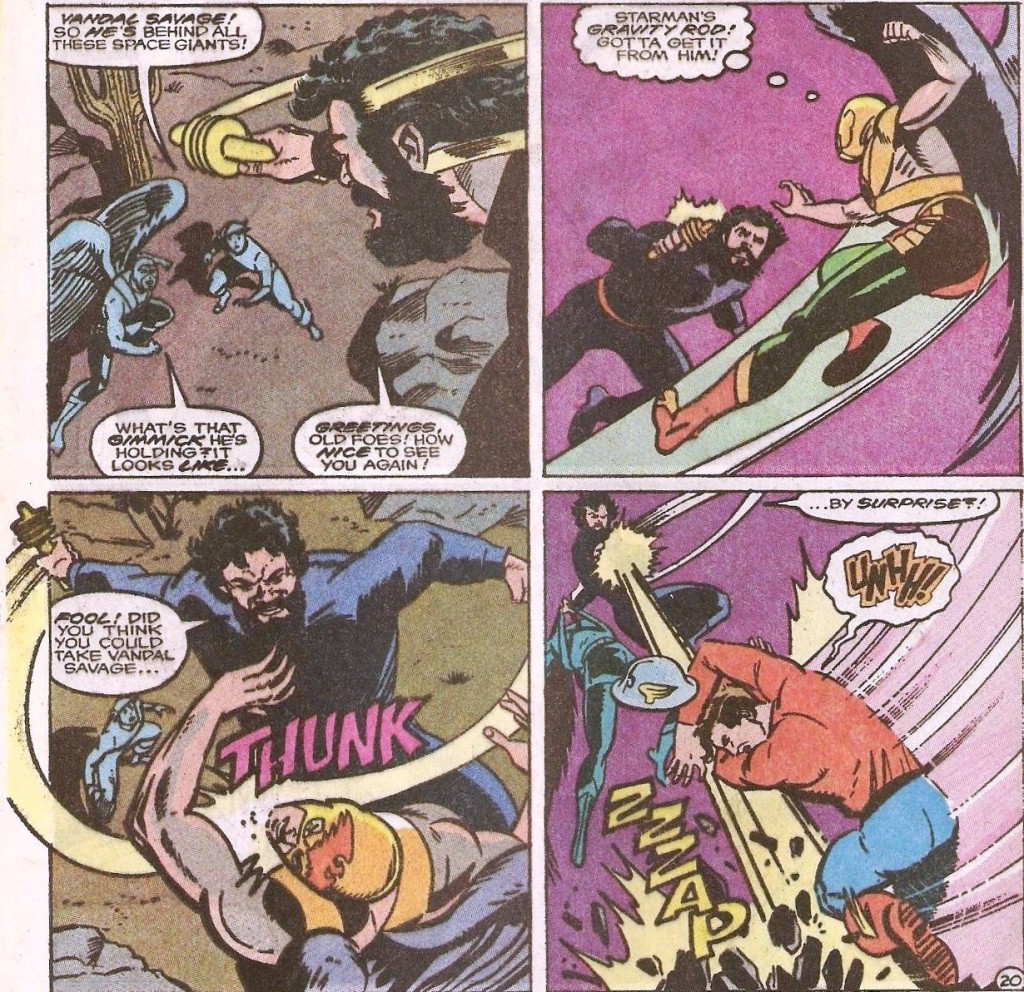

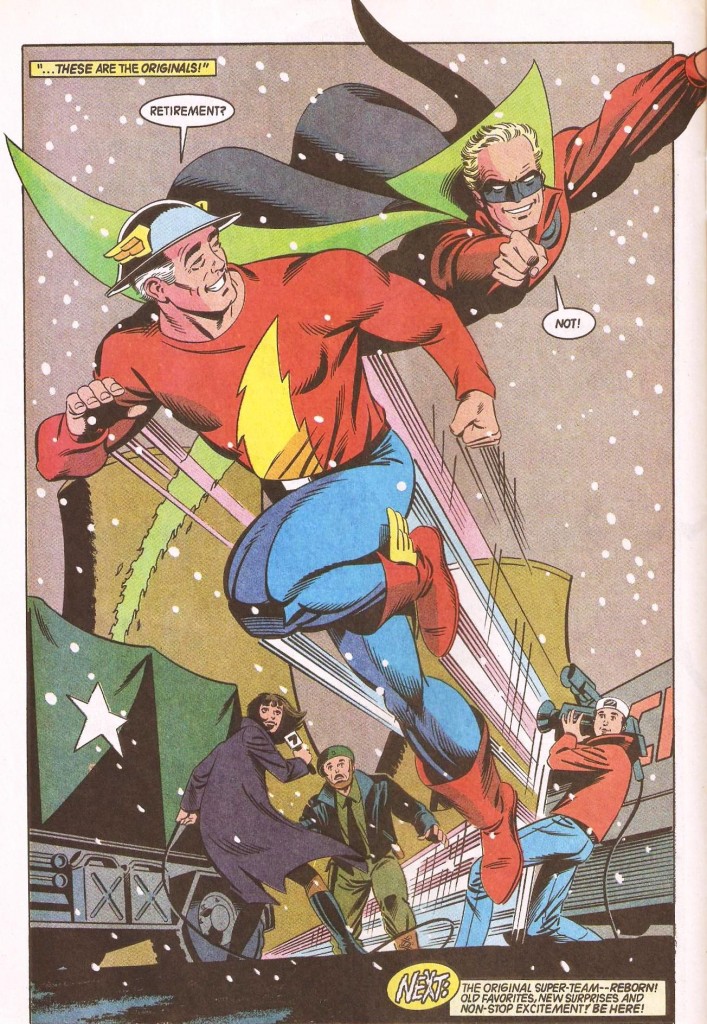
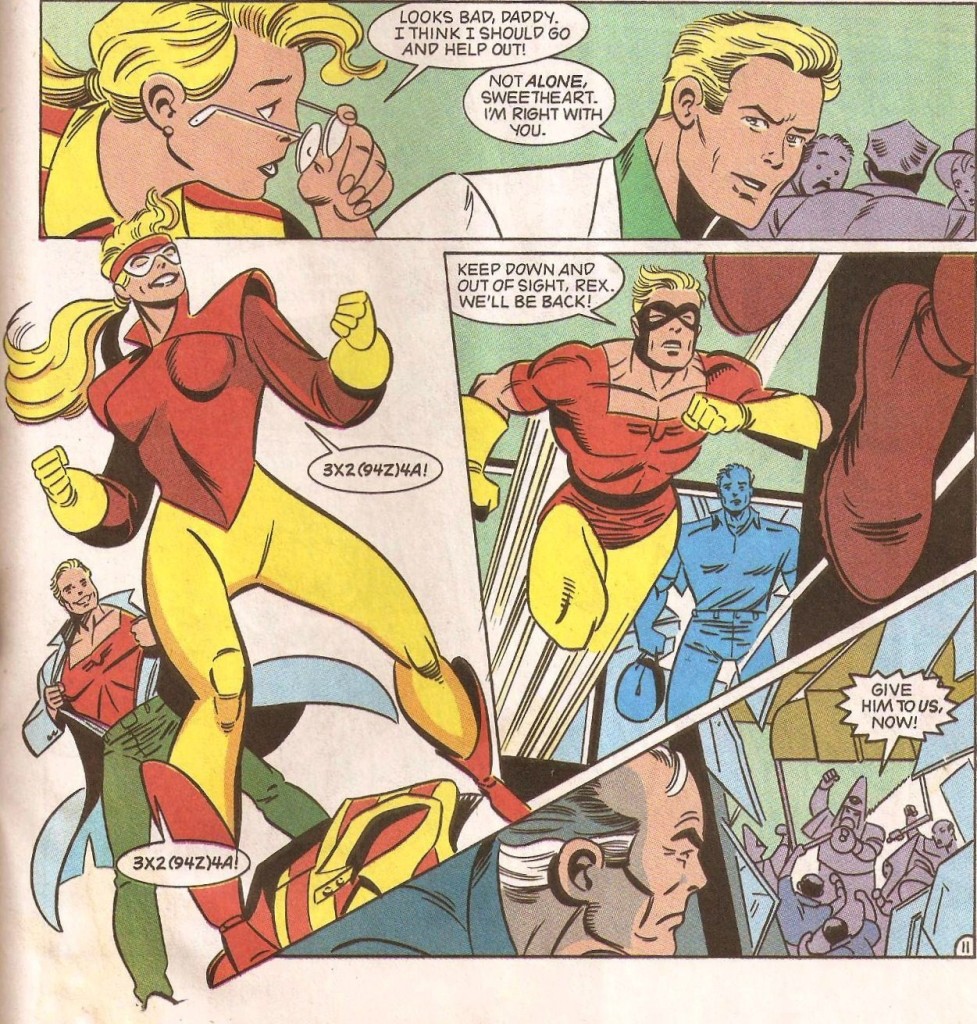
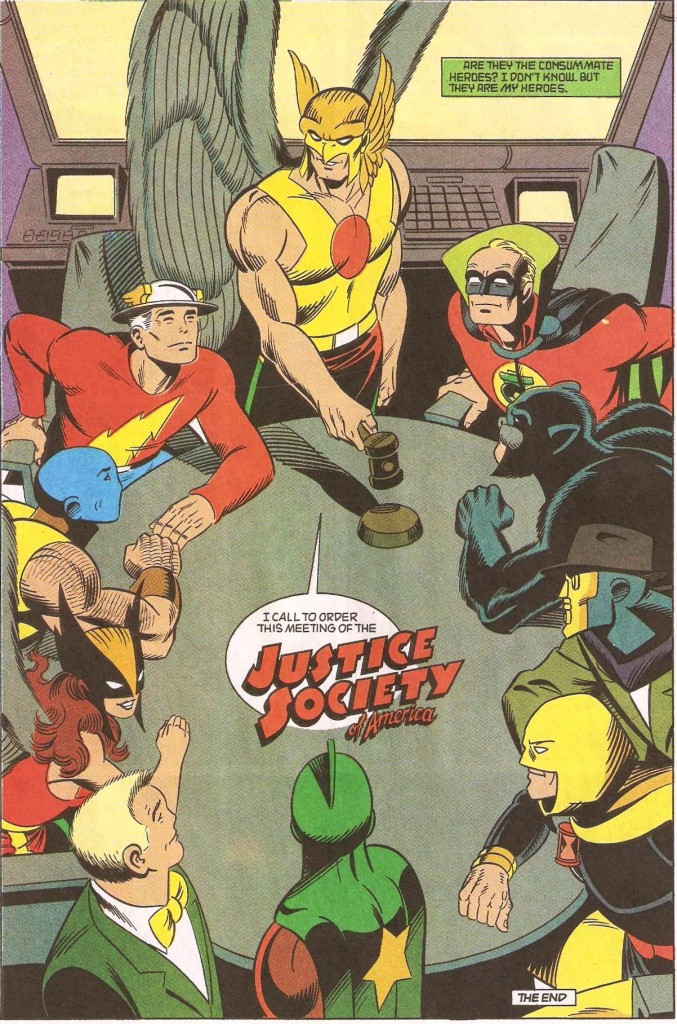
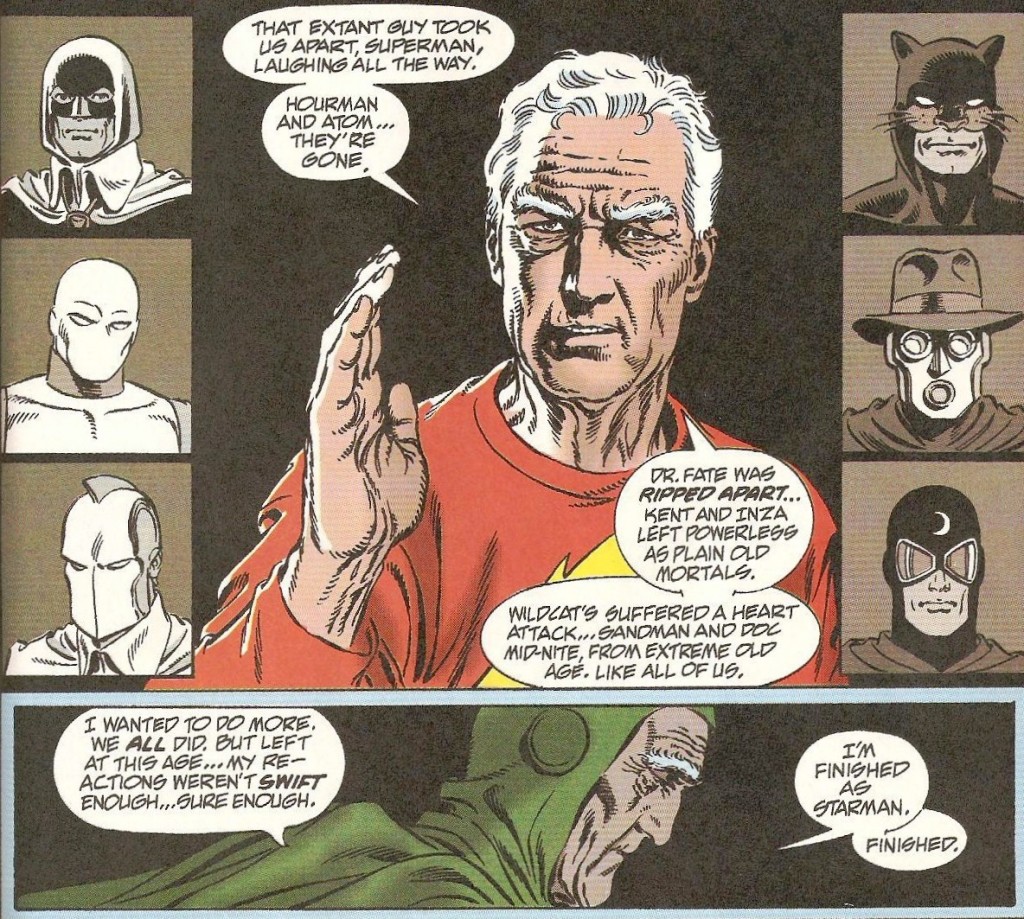

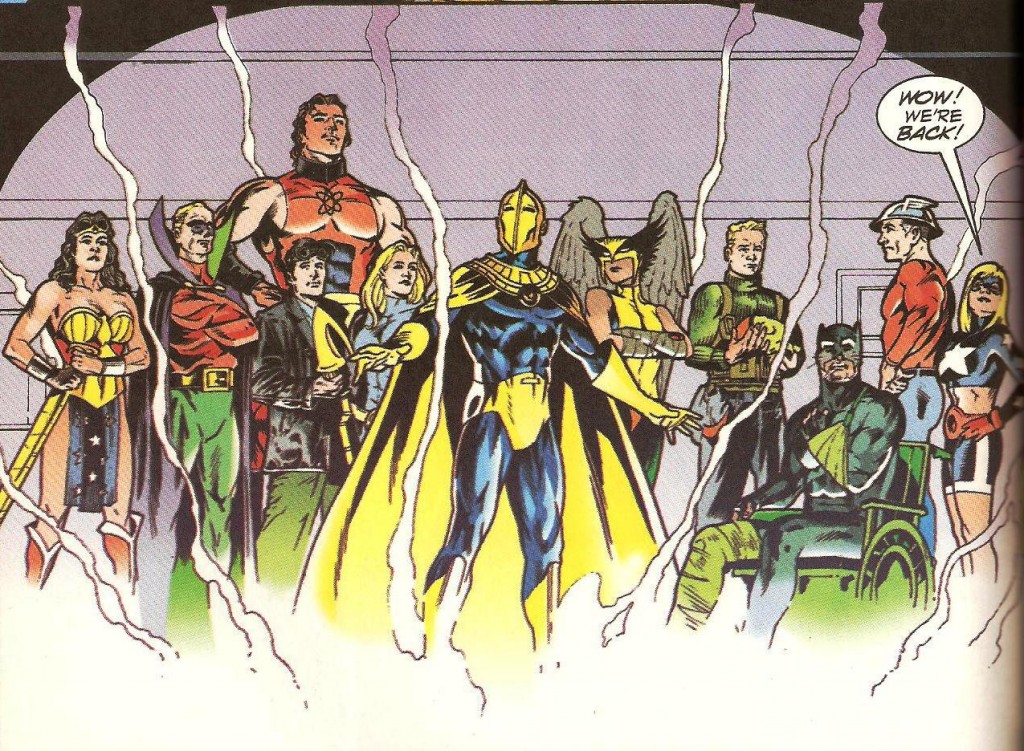

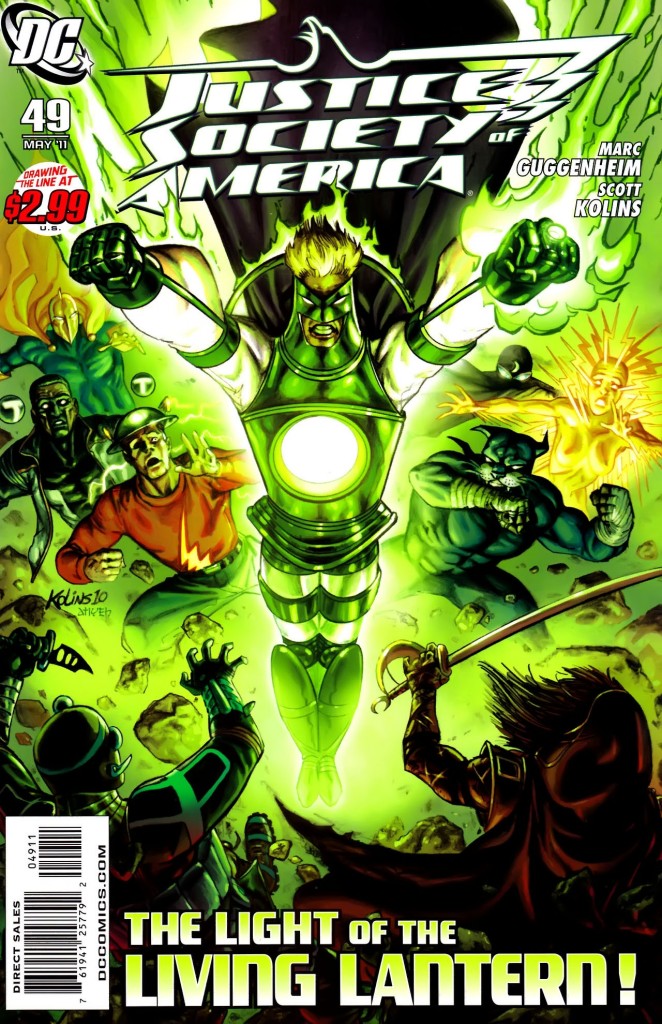


A very well written feature. Great read. Thanks! I’m not a JSA fan at all, and I had picked up the relaunch a few years ago and dropped it during the Legion cross-over. I couldn’t handle the number of characters that I knew nothing about.
I truly loved the Johns/Eaglesham era, Thy Kingdom Come was a great follow up.
Plus you had those top quality covers by Alex Ross!
I miss that Len Wein/Mike Parobeck series. My favorite Justice Society of America book of all time!
It was actually Len Strazewski who wrote it, but yeah, it’s my favorite as well. It’s really too bad that it hasn’t been collected yet. It’s got a great Ultra-Humanite story in it.
Ah, yes. For some reason the fact that the writer’s first name was Len has stuck with me all these years.
Conor, if you ever get a chance, try to track down the JSA stories in Adventure Comics from the 1970s with the death of the Earth-2 Batman and if I remember right, the introduction of the Huntress. Those were pretty good too and was the beginning of my appreciation of the JSA.
*sniff*
I miss the JSA, Jay Garrick, and Alan Scott.
I know they’re coming back in Earth 2 (sort of) but it’s not the same damn it!
man, that Geoff Johns Justice Society of America run was so damn good. I’d go so far to say that it was his best work. It’s inifinitely rereadable
Anyone know if the Len Strazewski / Mike Parobeck series was ever collected in trade ?
As far as I know, it hasn’t been. Sounds like Strazewski didn’t make many friends at DC when he left, so I’m not super surprised that it hasn’t been. It’s really a shame.
Love the JSA! I’m waiting to see what the Robinson reconstruction of Earth-2 looks like before I commit any money to a new series in the NuDC. Tradewaiting at best, revisiting my back issues at the worst.
After reading James Robinson’s excellent “The Golden Age” I became obsessed with the JSA. I tracked down everything I could to get me up to speed, and I STILL don’t know a lot. SO much history there. But I think this article captured most of what you need to know to have a functional understanding of the JSA, so well done!
I really miss the JSA. You are correct, it was more than just a team, it was a family. There were legacy members whose parents or relatives were in previously, new members who needed the guidance of these senior heroes, the older generation questioning their relevance… I don’t think we’re going to get the same type of thing in Earth 2, but I am going to try it in the hope that I will be pleasantly surprised.
A pretty good summary of the history of the JSA – not one of – but THE first AND best superteam in comics history!
R.I.P.
I say that because you will probably never see them again! (unless in an ‘Elseworld’s’ tale!)
I have just read the abomination that is callled “Earth 2″# 1 today and as a result, will not buy it, or another DC title ever again.
This book is NOT about “Earth 2” – it is about “nu Earth 2” – which uis just a carbon copy of the awful, rebbiooted nu52 world we already love to hate! This will therefore be a book about a ‘nuJSA’ – NOT the original, classic team discussed above!
Don’t be fooled!
There is nothing new here – in fact it is goddam awful! The same old same old grim, dark, violent ‘edgy’ world – God help us!
The only thing DC is using from the JSA and the (proper) Earth 2 is the JSA characters names! Only therir names mind you – nothing else is recognisable – origins, histories, costumes, characters, contexts – NOTHING!!
They are USING that to lure you in, and into hoping it will make people think that this is the JSA – and the character’s youth – well it isn’t – what it is, is A COMPLETELY DIFFERENT SET OF CHARACTERS ALTOGETHER!!
There is NO resemblence to the JSA we know at all!
DON’T BUY IT – BOYCOTT THIS AWFUL BOOK!!!
I actually feel it’s one of the best books out this week.
Yeah, I really liked the book too. In fact , I’m really looking forward to reading more of it.
Terrific article, Jeff! I used to love those JLA/JSA stories back in the day (*hint hint* DC). And @TheNextChampion, I feel your pain – fingers crossed for Earth 2…..
Love em, All-Star Comics #3 is my all favorite iconic image in comics and love the homage JSA vol.3 #1 issue, the blend of multi-generational characters of old and new gave me the Watchmen/Minutemen feel and love it, the original sketch had a cpl og JSA members I wish would’ve made the final cut. My handle is obviously kind of an oxy-moron as they’re the oldest team and I use the word kid but did so cause at 30 is when I fell in love with these characters by reading in retrospect and consider them my connection and to the entire DCU aside from Batman. The Shade is one of my favorite series right now and loved James Robinsons Starman run and anything else JSA connected fro the most part. Here’s hoping James and Nikola Scott usher the JSA with Earth-2 into the new age with class and substance. I believe they’re in good hands.
I remember getting the 1991 JSA # 5, with a team up between Hawkman & The Flash and I loved it, then I found the whole mini series at a thrift store in Madison, it was a great series.
Plus, in regards to this: https://ifanboy.com/articles/great-moments-in-comics-history-smash-comics-1/
If that owl isn’t in some way connected to The Court of Owls, then their threat level is severely lessened. If it is, whores and Batman better beware.
I’ve enjoyed the JSA since I first discovered them in Justice League of America 101 (the annual JLA/JSA team-up that reintroduced the Seven Soldiers of Victory).
Too bad DC won’t keep their heritage in tact anymore . . . unless they reintroduce Golden Age characters with Golden Age backgrounds on another Earth some day. (Won’t be holding my breath waitinbg for that.)
At least Marvel Comics hasn’t completely abandoned characters with historical WWII connections, even if they did cancel the latest All Winners Squad limited series before it was actually finished.